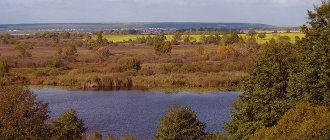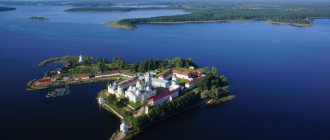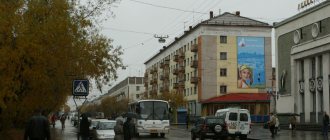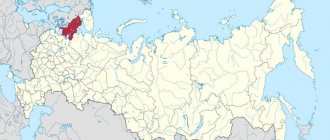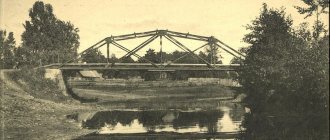The Novgorod region is located in the European part of the country in its northwestern part. The region has a glorious history. Once upon a time, the lands of the region belonged to Kievan Rus, and from the 12th century. Veliky Novgorod became one of the largest city-states in Europe. Use satellite maps of the Novgorod region to get an idea of this region, consider its borders, cities and other settlements.
The borders of the region on 4 sides limit the territories of such areas as:
- Leningradskaya;
- Vologda;
- Pskovskaya;
- Tverskoy.
Hydrographic objects are displayed on the map of the Novgorod region with diagrams. In the center of the region is the large Lake Ilmen, surrounded by picturesque shores, a large number of recreation centers and beaches. Several large lakes are also located in the southeastern part of the region - Valdai, Seliger, etc.
There are more than 50 rivers in the region, most of them flow into the Ilmen. In different areas on the map of the Novgorod region you can see the following rivers:
- Volkhov;
- Lovat;
- Shelon;
- Kholynya;
- Redhya;
- Veryazha.
Tourists often come to the region. A large number of architectural monuments have been preserved here, as well as fishing and other outdoor activities. When going on a trip, use maps of the Novgorod region with districts. The online service will help you navigate your way by choosing the right road, finding cities, and considering the location of streets, train stations, shops and restaurants.
Content
- 1 Administrative-territorial structure 1.1 Districts and cities of regional significance
- 4.1 Batetsky district
Archaeological research
The main medieval monument of Novgorod is its cultural layer, reaching 9 m. Clay soils do not allow air to pass through and do not absorb moisture, water oozes through the layers, preventing the access of air, thereby eliminating the process of decay of organic residues. Products made of wood, metal, bone, and leather are well preserved. The complete preservation of the layers corresponding to narrow periods of time makes it possible to clarify the ancient layout of the excavated area. The objects found in them make it possible to understand the purpose of the buildings, the standard of living of the inhabitants, and the nature of their occupations. Thousands of log buildings have been opened. The size of the estates reaches 300-1500 square meters. m. A weather dendrochronological scale has been developed; material complexes are dated with an accuracy of up to 10 years. The oldest pavement dates back to 953. Among the things found were ships, sleighs, furniture, utensils, dishes, children's toys, musical instruments, weapons, and jewelry.
The oldest (first half of the 11th century) of almost eight hundred birch bark letters preserved the text of the conspiracy in ancient German: “Never hit him with an arrow.” Around the same time, an exquisite message from a young woman with a high social position and familiar with the literary language to her lover who did not come on a date dates back to her: “What kind of evil do you have against me that you didn’t come to me this week? And I treated you like a brother! Did I really offend you by sending you? But I see you don’t like it. If you cared, you would have escaped from under (human) eyes and come... now somewhere else. Write to me about... (don’t think that I) am rejecting you. Even if I “hurt you with my stupidity,” if you start to mock me, then God and “my thinness” (= me) will judge (you). The ceras (waxed tablets for writing) with the texts of the Psalter (ninth kathisma) and an unparalleled text of a conspiracy or sermon, found in 2000, date back no later than the first quarter of the 10th century. and are the oldest surviving Slavic texts.
Archaeological sources also make it possible to resolve fundamental issues in the history of material and spiritual culture, economics and politics. Linguistic analysis of birch bark texts led to the discovery of the Old Novgorod dialect, related to the languages of the Slavs of the southern Baltic (which means the Slavs came here not from the middle Dnieper region, as previously thought, but from the Western Slavic regions). The second important observation concerns the reasons for the emergence of a boyar republic in Novgorod. Early birch bark letters showed that state taxes were initially collected by the aristocratic elite of society on the basis of an agreement with the prince, which formed the basis of its economic power. The layer of other cities preserves only a negligible part of the antiquities, while Novgorod allows us to reconstruct an almost complete picture of the life of medieval townspeople. During excavations carried out since 1932, archaeologists have explored no more than 2% of the ancient territory. All R. 16th century the market housed more than 1,500 shops, and there were over 200 craft professions. During the Time of Troubles, Novgorod suffered from the Swedish occupation (1611-1617).
Administrative-territorial structure[ | ]
Districts of the Novgorod region
According to the Charter of the region and the Law “On the administrative-territorial structure of the Novgorod region
", subject of the Russian Federation includes[1][2][3]
- 3 cities of regional significance (Borovichi, Veliky Novgorod, Staraya Russa), with Borovichi and Staraya Russa being part of the administrative districts;
- 21 districts, which includes: 7 cities of regional significance (Valdai, Malaya Vishera, Okulovka, Pestovo, Soltsy, Kholm, Chudovo)
- 11 urban-type settlements (working villages): Demyansk, Demyansky district, Kresttsy, Krestetsky district, Kulotino, Okulovsky district, Lyubytino, Lyubytinsky district, Nebolchi, Lyubytinsky district, Pankovka, Novgorod district, Parfino, Parfinsky district, Proletary, Novgorod district, Uglovka, Okulovsky district, Khvoynaya, Khvoininsky district, Shimsk Shimsky district
- 113 settlements[4]
- rural settlements
The administrative center of the region is the city of Veliky Novgorod.
Districts and cities of regional significance[ | ]
| No. on the map | Name | OKATO | Area (km²) | Population (persons) 2022 | Admin. center | Population of the center (persons) |
| 1e-06 | Districts | |||||
| 1 | Batetsky district | 49 203 | 1591,79 | ↘5018[5] | village Batetsky | ↘2258[6] |
| 2 | Borovichi district[7] | 49 206 | 3137,90 | ↘62 502[5] | Borovichi | ↘48 858[8] |
| 3 | Valdai district | 49 208 | 2701,63 | ↘22 854[5] | Valdai | ↘13 800[8] |
| 4 | Volotovsky district | 49 210 | 995,10 | ↘4512[5] | village Volot | ↘2236[6] |
| 5 | Demyansky district | 49 212 | 3198,94 | ↘9964[5] | urban village Demyansk | ↘4148[8] |
| 6 | Krestetsky district | 49 214 | 2790,63 | ↘11 180[5] | village Krestsy | ↘7249[8] |
| 7 | Lyubytinsky district | 49 216 | 4486,24 | ↘8288[5] | urban village Lyubytino | ↘2312[8] |
| 8 | Malovishersky district | 49 220 | 3280,98 | ↘14 172[5] | Malaya Vishera | ↘10 161[8] |
| 9 | Marevsky district | 49 223 | 1818,70 | ↘3902[5] | Maryovo village | ↘2297[6] |
| 10 | Moshensky district | 49 224 | 2568,28 | ↘5970[5] | Moshenskoye village | ↘2065[5] |
| 11 | Novgorod district | 49 225 | 4596,36 | ↗63 225[5] | Veliky Novgorod | ↗225 019[8] |
| 12 | Okulovsky district | 49 228 | 2520,81 | ↘20 225[5] | Okulovka | ↘9510[8] |
| 13 | Parfinsky district | 49 230 | 1591,12 | ↘12 220[5] | Parfino village | ↘6258[8] |
| 14 | Pestovsky district | 49 232 | 2110,44 | ↘19 865[5] | Pestovo | ↘14 842[8] |
| 15 | Poddorsky district | 49 234 | 2954,02 | ↘3695[5] | Poddorye village | ↘1860[6] |
| 16 | Soletsky district | 49 238 | 1422,91 | ↘13 183[5] | Soltsy | ↘8336[8] |
| 17 | Starorussky district[9] | 49 239 | 3111,36 | ↘41 493[5] | Staraya Russa | ↘27 377[8] |
| 18 | Khvoyninsky district | 49 245 | 3186,06 | ↘13 734[5] | village Khvoynaya | ↘5559[8] |
| 19 | Kholmsky district | 49 247 | 2178,69 | ↘5039[5] | Holm | ↘3344[8] |
| 20 | Chudovsky district | 49 250 | 2331,80 | ↘19 566[5] | Chudovo | ↘13 764[8] |
| 21 | Shimsky district | 49 255 | 1836,76 | ↘10 965[5] | village Shimsk | ↘3484[8] |
| 21.000002 | Cities of regional significance[10] | |||||
| 21.000003 | Velikiy Novgorod | 49 401 | 90,08 | ↗225 019[8] | Veliky Novgorod | ↗225 019[8] |
| 21.000004 | Borovichi | 49 408 | ↘48 858[8] | Borovichi | ↘48 858[8] | |
| 21.000005 | Staraya Russa | 49 413 | ↘27 377[8] | Staraya Russa | ↘27 377[8] |
Municipal structure[ | ]
Within the framework of the municipal structure of the region, within the boundaries of the administrative-territorial units of the Novgorod region, a total of 142 municipalities were formed (as of January 1, 2016)[11]:
- 1st urban district (Veliky Novgorod);
- 21 municipal districts, including 19 urban settlements,
- 101 rural settlements.
In March 2022, Volotovsky[12], Marevsky[13], Soletsky[14] and Khvoyninsky[15] municipal districts were transformed into municipal districts, all cities and settlements that were part of them were abolished.
Since 2022, the municipal structure of the Novgorod region looks like this:
- 1st urban district (Veliky Novgorod);
- 4 municipal districts;
- 17 municipal districts, including 17 urban settlements,
- 81 rural settlements.
Economy and industry of the Novgorod region
The economic component of the region is represented by industry and agriculture. There are enterprises in the following industries in the region:
- metallurgy;
- mechanical engineering;
- food;
- woodworking;
- pulp and paper.
Agriculture is dominated by the cultivation of vegetables and root crops, as well as poultry farming. One of the largest farming enterprises in the region is Novgorod Bacon. This complex accounts for almost all the volumes of milk and pork production in the region.
Municipal districts and districts[ | ]
| № | Name | Flag | Coat of arms | Area, km² | Population, people (2020) | Admin. center | Population of the center, people |
| 1e-06 | Municipal districts | ||||||
| 1 | Batetsky district | 1 591,79 | ↘5018[5] | village Batetsky | ↘2258[6] | ||
| 2 | Borovichi district | 3 137,90 | ↘62 502[5] | Borovichi | ↘48 858[8] | ||
| 3 | Valdai district | 2 701,63 | ↘22 854[5] | Valdai | ↘13 800[8] | ||
| 4 | Demyansky district | 3 198,94 | ↘9964[5] | urban village Demyansk | ↘4148[8] | ||
| 5 | Krestetsky district | 2 790,63 | ↘11 180[5] | village Krestsy | ↘7249[8] | ||
| 6 | Lyubytinsky district | 4 486,24 | ↘8288[5] | urban village Lyubytino | ↘2312[8] | ||
| 7 | Malovishersky district | 3 280,98 | ↘14 172[5] | Malaya Vishera | ↘10 161[8] | ||
| 8 | Moshensky district | 2 568,28 | ↘5970[5] | Moshenskoye village | ↘2065[5] | ||
| 9 | Novgorod district | 4 596,36 | ↗63 225[5] | Veliky Novgorod | ↗225 019[8] | ||
| 10 | Okulovsky district | 2 520,81 | ↘20 225[5] | Okulovka | ↘9510[8] | ||
| 11 | Parfinsky district | 1 591,12 | ↘12 220[5] | Parfino village | ↘6258[8] | ||
| 12 | Pestovsky district | 2 110,44 | ↘19 865[5] | Pestovo | ↘14 842[8] | ||
| 13 | Poddorsky district | 2 954,02 | ↘3695[5] | Poddorye village | ↘1860[6] | ||
| 14 | Starorussky district | 3 111,36 | ↘41 493[5] | Staraya Russa | ↘27 377[8] | ||
| 15 | Kholmsky district | 2 178,69 | ↘5039[5] | Holm | ↘3344[8] | ||
| 16 | Chudovsky district | 2 331,80 | ↘19 566[5] | Chudovo | ↘13 764[8] | ||
| 17 | Shimsky district | 1 836,76 | ↘10 965[5] | village Shimsk | ↘3484[8] | ||
| 17.000002 | Municipal districts | ||||||
| 18 | Volotovsky district | 995,10 | ↘4512[5] | village Volot | ↘2236[6] | ||
| 19 | Marevsky district | 1 818,70 | ↘3902[5] | Maryovo village | ↘2297[6] | ||
| 20 | Soletsky district | 1 422,91 | ↘13 183[5] | Soltsy | ↘8336[8] | ||
| 21 | Khvoyninsky district | 3 186,06 | ↘13 734[5] | village Khvoynaya | ↘5559[8] | ||
| 21.000003 | Urban district | ||||||
| 22 | Velikiy Novgorod | 90,08 | ↗225 019[8] | Veliky Novgorod | ↗225 019[8] |
Settlements[ | ]
Batetsky district[ | ]
Administrative center - the village of Batetsky
| Municipality | Administrative center |
| Batetskoe rural settlement | Batetsky village |
| Moikinskoe rural settlement | Moika village |
| Peredolskoe rural settlement | village of Novoye Ovsino |
By Law of the Novgorod Region of March 31, 2009 No. 498-OZ[16], which came into force on April 17, 2009, the Batetskoye and Gorodenskoye rural settlements were united into the Batetskoye rural settlement with the administrative center in the village of Batetskoye.
By Law of the Novgorod Region of March 30, 2010 No. 714-OZ[17], which came into force on April 12, 2010, the Volnogorskoye and Moikinskoye rural settlements were united into the Moikinskoye rural settlement with the administrative center in the village of Moika.
Borovichi district[ | ]
Administrative center - the city of Borovichi
| Municipality | Administrative center |
| urban settlement Borovichi | city of Borovichi |
| Volokskoe rural settlement | Volok village |
| Yogol rural settlement | Yogla village |
| Zhelezkovskoe rural settlement | Zhelezkovo village |
| Konchansko-Suvorovskoye rural settlement | village Konchanskoye-Suvorovskoye |
| Opechenskoe rural settlement | Opechensky Posad village |
| Peredskoe rural settlement | Peredki village |
| Progressive rural settlement | Progress village |
| Sushanskoe rural settlement | Koegoshcha village |
| Sushilovskoye rural settlement | Sushilovo village |
| Travkovskoe rural settlement | Travkovo village |
The Law of the Novgorod Region of March 30, 2010 No. 715-OZ[18], which entered into force on April 12, 2010, combines:
- Volokskoye and Kirovskoye rural settlements - into the Volokskoye rural settlement with the administrative center in the village of Volok;
- Zhelezkovskoye, Plavkovskoye and Rechenskoye rural settlements - into the Zhelezkovskoye rural settlement with the administrative center in the village of Zhelezkovo;
- Konchansko-Suvorovskoye and Udinskoye rural settlements - into the Konchansko-Suvorovskoye rural settlement with the administrative center in the village of Konchansko-Suvorovskoye;
- Opechenskoye and Pereluchskoye rural settlements - into the Opechenskoye rural settlement with the administrative center in the village of Opechensky Posad;
- Peredskoye and Pochinno-Sopkinskoye rural settlements - into Peredskoye rural settlement with the administrative center in the village of Peredki.
Valdai district[ | ]
Administrative center is the city of Valdai
| Municipality | Administrative center |
| Valdai urban settlement | Valdai city |
| Edrovskoe rural settlement | village of Edrovo |
| Ivanteevskoye rural settlement | Ivanteevo village |
| Korotskoe rural settlement | Korotsko village |
| Kostkovskoe rural settlement | Kostkovo village |
| Lyubnitskoe rural settlement | village Lyubnitsa |
| Roshchinskoe rural settlement | Roshchino village |
| Semyonovshchinskoe rural settlement | Semenovshchina village |
| Yazhelbitskoe rural settlement | Yazhelbitsy village |
By Law of the Novgorod Region of March 30, 2010 No. 716-OZ[19], which came into force on April 12, 2010, the Roshchinskoye and Shuyskoye rural settlements were united into the Roshchinskoye rural settlement with the administrative center in the village of Roshchino.
Volotovsky district[ | ]
Administrative center is the village of Volot
| Municipality | Administrative center |
| rural settlement Volot | Volot village |
| Ratitsky settlement | Volot village |
| Slavitinskoe rural settlement | Slavitino village |
The Law of the Novgorod Region of March 30, 2010 No. 717-OZ[20], which entered into force on April 12, 2010, combines:
- the rural settlement of Volot and the Vzglyadskoye rural settlement - into the rural settlement of Volot with the administrative center in the village of Volot;
- Volotovskoye, Ratitskoye and Gorodetskoye rural settlements - into the Gorskoye rural settlement with the administrative center in the village of Volot.
By Law of the Novgorod Region of March 27, 2022 No. 531-OZ[12], it was transformed into a municipal district, all rural settlements were abolished.
Demyansky district[ | ]
The administrative center is the town. Demyansk
| Municipality | Administrative center |
| Demyansk urban settlement | village Demyansk |
| Zhirkovskoe rural settlement | Zhirkovo village |
| Ilyinogorsk rural settlement | Shishkovo village |
| Knevitskoe rural settlement | Knevitsy village |
| Lychkovskoe rural settlement | village of Lychkovo |
| Pesotskoe rural settlement | Peski village |
| Polnovskoe rural settlement | village Polnovo |
| Yamnikskoe rural settlement | Yamnik village |
The Law of the Novgorod Region of March 30, 2010 No. 718-OZ[21], which entered into force on April 12, 2010, combines:
- Zhirkovskoe, Velikozakhodskoe and Tarasovskoe rural settlements - into the Zhirkovskoe rural settlement with the administrative center in the village of Zhirkovo;
- Ilyinogorskoye, Votolinskoye and Shishkovskoye rural settlements - into Ilyinogorskoye rural settlement with the administrative center in the village of Ilyina Gora;
- Pesotskoye, Bolshelukskoye, Nikolskoye and Filippogorskoye rural settlements - into Pesotskoye rural settlement with the administrative center in the village of Peski;
- Polnovskoye, Dubrovskoye and Novoskrebelskoye rural settlements - into the Polnovskoye rural settlement with the administrative center in the village of Polnovo;
- Yamnikskoye and Chernorucheyskoye rural settlements - into the Yamnikskoye rural settlement with the administrative center in the village of Yamnik.
Since November 2022, the administrative center of the Ilyinogorsk rural settlement has been moved from the village of Ilyina Gora[22] to the village of Shishkovo. In July 2022, the village of Shishkovo was also designated as the center of the Ilyinogorsk settlement of the same name as an administrative-territorial unit of the Demyansky district[23].
Krestetsky district[ | ]
The administrative center is the town. Sacrum
| Municipality | Administrative center |
| Krestetskoye urban settlement | village Sacrum |
| Zaitsevskoe rural settlement | Zaitsevo village |
| Novorakhinskoye rural settlement | village of Novoye Rakhino |
| Ruchevskoe rural settlement | Ruchi village |
| Ustvolmskoe rural settlement | Ust-Volma village |
The Law of the Novgorod Region of March 30, 2010 No. 719-OZ[24], which entered into force on April 12, 2010, combines:
- Lokotskoye, Novorakhinskoye and Somenskoye rural settlements - into the Novorakhinskoye rural settlement with the administrative center in the village of Novoye Rakhino;
- Vinskoye and Ustvolmskoye rural settlements - into Ustvolmskoye rural settlement with the administrative center in the village of Ust-Volma.
Lyubytinsky district[ | ]
The administrative center is the town. Lyubytino
| Municipality | Administrative center |
| Lyubytinskoye rural settlement | village Lyubytino |
| Nebolch rural settlement | village Be quiet |
Malovishersky district[ | ]
Administrative center - the city of Malaya Vishera
| Municipality | Administrative center |
| Malovisherskoe urban settlement | Malaya Vishera town |
| Bolshevisherskoye urban settlement | Bolshaya Vishera village |
| Burginskoe rural settlement | Burga village |
| Verebyinskoye rural settlement | Verebye village |
Marevsky district[ | ]
Administrative center - the village of Maryovo
| Municipality | Administrative center |
| Velilskoe rural settlement | Velily village |
| Marevskoe rural settlement | Maryovo village |
| Moiseevskoye rural settlement | Moiseevo village |
| Molvotitskoe rural settlement | Molvotitsy village |
The Law of the Novgorod Region of March 3, 2010 No. 699-OZ[25], which entered into force on April 12, 2010, combines:
- Marevskoye and Lipevskoye rural settlements - into Marevskoye rural settlement with the administrative center in the village of Maryovo;
- Molvotitskoye and Gornoe rural settlements - into Molvotitskoye rural settlement with the administrative center in the village of Molvotitsy.
By Law of the Novgorod Region of March 27, 2022 No. 530-OZ[13], it was transformed into a municipal district, all rural settlements were abolished.
Moshensky district[ | ]
Administrative center - the village of Moshenskoye
| Municipality | Administrative center |
| Dolgovskoe rural settlement | Dolgoe village |
| Kalinin rural settlement | village of New Posyolok |
| Kirov rural settlement | Sloptovo village |
| Moshenskoe rural settlement | Moshenskoye village |
| Orekhovskoe rural settlement | village of Orekhovno |
The Law of the Novgorod Region of March 30, 2010 No. 720-OZ[26], which entered into force on April 12, 2010, combines:
- Dolgovskoye, Brodskoye and Krasnogorskoye rural settlements - into the Dolgovskoye rural settlement with the administrative center in the village of Dolgoye;
- Kalininskoye and Kabozhskoye rural settlements - into the Kalininskoye rural settlement with the administrative center in the village of Novy Poselok;
- Kirovskoye, Ostashevskoye, Baryshovskoye, Megletskoye and Ustrekskoye rural settlements - into the Kirovskoye rural settlement with the administrative center in the village of Sloptovo;
- Orekhovskoye, Gorodishchenskoye, Dubishkinskoye and Chuvashevogorskoye rural settlements - into the Orekhovskoye rural settlement with the administrative center in the village of Orekhovno.
Novgorod district[ | ]
The administrative center is located in the city of Veliky Novgorod.
| Municipality | Administrative center |
| Pankovskoe urban settlement | village Pankovka |
| Proletarian urban settlement | village Proletarian |
| Borkovskoe rural settlement | Borki village |
| Bronnitskoe rural settlement | Bronnitsa village |
| Ermolinskoe rural settlement | Ermolino village |
| Lesnovskoe rural settlement | Lesnaya village |
| Rakom rural settlement | village of Old Rakomo |
| Savinskoe rural settlement | Savino village |
| Tesovo-Netylskoe rural settlement | village Tesovo-Netylsky |
| Trubichinskoe rural settlement | Trubichino village |
By Law of the Novgorod Region of March 30, 2010 No. 721-OZ[27], which entered into force on April 12, 2010, the following municipalities were transformed by merging them:
- Gostetskoye rural settlement and Proletarskoye urban settlement - into Proletarskoye urban settlement with the administrative center in the working village of Proletary;
- Tesovo-Netylsky urban settlement and Selogorskoye rural settlement - into Tesovo-Netylsky urban settlement with the administrative center in the village of Tesovo-Netylsky;
- Bozhonskoye rural settlement and Novoselitskoye rural settlement - into Novoselitskoye rural settlement with the administrative center in the village of Novoselitsy;
- Borkovskoye rural settlement and Sergovskoye rural settlement - into Borkovskoye rural settlement with the administrative center in the village of Borki;
- Ermolinskoye rural settlement and Novomelnitskoye rural settlement - into Ermolinskoye rural settlement with the administrative center in the village of Ermolino.
By Law of the Novgorod Region of April 1, 2014 No. 533-OZ[28], the following municipalities were transformed by merging them:
- Ermolinskoye rural settlement, Grigorovskoye rural settlement and Syrkovskoye rural settlement - into Ermolinskoye rural settlement with the administrative center in the village of Ermolino;
- Novoselitskoye rural settlement, Savinskoye rural settlement and Volotovskoye rural settlement - into Savinskoye rural settlement with the administrative center in the village of Savino;
- Podberezskoye rural settlement, Trubichinskoye rural settlement and Chechulinskoye rural settlement - into Trubichinskoye rural settlement with the administrative center in the village of Trubichino;
- Tesovo-Netylskoye urban settlement and Tesovskoye urban settlement - into Tesovo-Netylskoye rural settlement with the administrative center in the village of Tesovo-Netylsky.
Okulovsky district[ | ]
Administrative center is the city of Okulovka
| Municipality | Administrative center |
| Okulovskoye urban settlement | Okulovka city |
| Kulotinskoe urban settlement | village Kulotino |
| Uglovskoe urban settlement | village Uglovka |
| Berezovikskoe rural settlement | village Berezovik |
| Borovenkovskoe rural settlement | Borovenka village |
| Kotovskoye rural settlement | Kotovo village |
| Turbino rural settlement | Melnitsa village |
By Law of the Novgorod Region of March 30, 2010 No. 722-OZ[29], which came into force on April 12, 2010, the Uglovskoe urban settlement and the Ozerkovskoe rural settlement were united into the Uglovskoe urban settlement with the administrative center in the working village of Uglovka.
Parfinsky district[ | ]
The administrative center is the town. Parfino
| Municipality | Administrative center |
| Parfinskoe urban settlement | village Parfino |
| Polava rural settlement | Pola village |
| Fedorkovskoe rural settlement | Fedorkovo village |
The Law of the Novgorod Region of March 30, 2010 No. 723-OZ[30], which entered into force on April 12, 2010, combines:
- Lazhinskoye, Sergeevskoye, Fedorkovskoye and Yuryevskoye rural settlements - into Fedorkovskoye rural settlement with the administrative center in the village of Fedorkovo;
- Kuzminskoye, Novoderevenskoye and Polavskoye rural settlements - into Polavskoye rural settlement with the administrative center in the village of Pola.
Pestovsky district[ | ]
Administrative center is the city of Pestovo
| Municipality | Administrative center |
| Pestovskoe urban settlement | Pestovo city |
| Pestovskoye rural settlement | Russkoe Pestovo village |
| Bogoslovskoe rural settlement | Bogoslovo village |
| Bykovskoye rural settlement | Bykovo village |
| Vyatskoe rural settlement | Vyatka village |
| Laptevskoe rural settlement | Laptevo village |
| Okhonskoe rural settlement | Ohona village |
| Ustyutsk rural settlement | Ustyutskoye village |
Poddorsky district[ | ]
Administrative center - the village of Poddorye
| Municipality | Administrative center |
| Poddorsky rural settlement | Poddorye village |
| Belebelkovskoye rural settlement | Belebelka village |
| Seleevskoe rural settlement | Seleevo village |
Soletsky district[ | ]
Administrative center - the city of Soltsy
| Municipality | Administrative center |
| Soletskoye urban settlement | Soltsy town |
| Vybitskoye rural settlement | Vybiti village |
| Gorskoe rural settlement | Gorki village |
| Dubrovskoye rural settlement | Dubrovo village |
The Law of the Novgorod Region of March 30, 2010 No. 724-OZ[31], which entered into force on April 12, 2010, combines:
- Vybitskoye and Nevskoye rural settlements - into the Vybitskoye rural settlement with the administrative center in the village of Vybiti;
- Gorskoye and Kuklinskoye rural settlements - into Gorskoye rural settlement with the administrative center in the village of Gorki;
- Vshelskoye, Dubrovskoye and Sosnovskoye rural settlements - into Dubrovskoye rural settlement with the administrative center in the village of Dubrovo.
By Law of the Novgorod Region of March 27, 2022 No. 532-OZ[14], it was transformed into a municipal district, all rural and urban settlements were abolished.
Starorussky district[ | ]
Administrative center is the city of Staraya Russa
| Municipality | Administrative center |
| Velikoselskoe rural settlement | Velikoye Selo village |
| Vzvad rural settlement | Vzvad village |
| Zaluchskoye rural settlement | village of Zaluchye |
| Ivanovo rural settlement | Ivanovskoe village |
| Mednikovskoe rural settlement | Mednikovo village |
| Nagovskoe rural settlement | Nagovo village |
| Novoselskoe rural settlement | Novoselsky village |
| urban settlement city of Staraya Russa | Staraya Russa city |
The Law of the Novgorod Region of March 30, 2010 No. 725-OZ[32], which entered into force on April 12, 2010, combines:
- Astrilovskoye, Bolsheborskoye, Velikoselskoye, Susolovskoye and Tulebelskoye rural settlements - into Velikoselskoye rural settlement with the administrative center in the village of Velikoye Selo;
- Zaluchskoye, Korovitchinskoye and Pinaevogorskoye rural settlements - into Zaluchskoye rural settlement with the administrative center in the village of Zaluchye;
- Svyatogorshskoye and Utushkinskoye rural settlements - to Ivanovskoye rural settlement with the administrative center in the village of Ivanovskoye;
- Davydovskoye and Mednikovskoye rural settlements - into the Mednikovskoye rural settlement with the administrative center in the village of Mednikovo;
- Bolshevoronovskoye, Borisovskoye, Buregskoye, Lunshinskoye and Nagovskoye rural settlements - into the Nagovskoye rural settlement with the administrative center in the village of Nagovo;
- Novoselskoye and Probuzhdenskoye rural settlements - into the Novoselskoye rural settlement with the administrative center in the village of Novoselsky.
Khvoininsky district[ | ]
The administrative center is the town. Coniferous
| Municipality | Administrative center |
| Khvoininsky urban settlement | village Coniferous |
| Antsiferovskoe rural settlement | Antsiferovo village |
| Borovskoe rural settlement | Borovskoe village |
| Dvorishchenskoye rural settlement | Dvorishchi village |
| Zvyaginskoe rural settlement | Zvyagino village |
| Kabozhskoe rural settlement | railway station Kabozha |
| Migoloshchskoe rural settlement | Migoloschi village |
| Minets rural settlement | Mintsy village |
| Ostakhnovskoye rural settlement | Ostakhnovo village |
| Pesskoe rural settlement | Pes village |
| Yubileininskoe rural settlement | Yubileiny village |
By Law of the Novgorod Region of March 30, 2010 No. 726-OZ[33], which came into force on April 12, 2010, the Antsiferovskoye and Brodskoye rural settlements were united into the Antsiferovskoye rural settlement with the administrative center in the village of Antsiferovo.
By Law of the Novgorod Region of March 27, 2022 No. 529-OZ[15], it was transformed into a municipal district, all rural and urban settlements were abolished.
Kholmsky district[ | ]
Administrative center - the city of Kholm
| Municipality | Administrative center |
| Kholm urban settlement | city Hill |
| Krasnoborskoe rural settlement | Krasny Bor village |
| Morkhovskoe rural settlement | Morkhovo village |
| Togod rural settlement | Togod village |
The Law of the Novgorod Region of March 30, 2010 No. 727-OZ[34], which entered into force on April 12, 2010, combines:
- Krasnoborskoye and Navolokskoye rural settlements - into the Krasnoborskoye rural settlement with the administrative center in the village of Krasny Bor;
- Nakhodskoe and Togodskoe rural settlements - into Togodskoe rural settlement with the administrative center in the village of Togod.
Chudovsky district[ | ]
Administrative center is the city of Chudovo
| Municipality | Administrative center |
| Georgian rural settlement | Krasnofarforny village |
| Tregubovskoe rural settlement | Tregubovo village |
| Uspenskoe rural settlement | Uspenskoye village |
| urban settlement Chudovo city | Chudovo city |
Shimsky district[ | ]
Administrative center - urban settlement Shimsk
| Municipality | Administrative center |
| Shimskoe urban settlement | village Shimsk |
| Medvedskoe rural settlement | village of Medved |
| Podgoszcz rural settlement | Podgoschi village |
| Utorgoshskoye rural settlement | railway station Utorgosh |
The Law of the Novgorod Region of March 30, 2010 No. 728-OZ[35], which entered into force on April 12, 2010, combines:
- Shimskoye urban settlement, Borskoye and Korostynskoye rural settlements - into the Shimskoye urban settlement with the administrative center in the working village of Shimsk;
- Gorodishchenskoye and Utorgoshskoye rural settlements - to the Utorgoshskoye rural settlement with the administrative center Utorgoshskoye railway station;
- Krasnodvorskoye and Podgoshchi rural settlements - into Podgoshchi rural settlement with the administrative center in the village of Podgoshchi.
Monuments of the late Middle Ages
| Many temples have also reached us from the late 16th century (Procopius, Women of the Myrrh-Bearers, Savior on Khutyn), ser. 16th century (Philip on Nutnaya, Boris and Gleb in Plotniki, Nikita, Fyodor Tiron, several refectories). The subsequent more than 100-year period is not represented by anything. From the end of the 17th century. The Znamensky Cathedral and two suburban monasteries - Derevyanitsky and Vyazhishchisky - have been preserved. Both provide very unique examples of heavy-style buildings with patterns. In the Kremlin there are also a clock ringing (1673), Likhudov and the Nikitsky building from the 15th-17th centuries, a house with platbands at the Belfry. |
Provincial city
Until the beginning 18th century Novgorod remained one of the major economic and shopping centers. With the development of St. Petersburg, it is gradually losing its trade and economic importance, remaining one of the centers of flax growing. Since 1727 it has been a provincial town. In the end 18th - early 19th centuries the radial-semicircular layout of the Sofia side and the rectangular one on the Trade side were streamlined (general plans of 1778 and 1834). Fragments of the historical environment and buildings in the classicist style have been preserved (Travel Palace 1771, 1828; Guardhouse). Public places (18-19 centuries, now one of the museum buildings), the monument “Millennium of Russia” (1862, sculptor M. O. Mikeshin, architect V. A. Hartman). In the 19th century, Novgorod was a place of political exile (Herzen 1841, participants in the strike movement - 1890s). Weak industry - in 1913 there were only 17 enterprises, 450 workers.
Post-revolutionary period
In November 1917, Soviet power came to the city. In January 1918 he survived the revolt of the Socialist Revolutionaries and Mensheviks. In 1939 it had 69 industrial enterprises (ship repair, foundry, and tile factories). The number of workers (since 1913) has increased 20 times. From August 15, 1941 to January 19, 1944 it was occupied by Nazi troops. After the occupation, out of 2,532 residential buildings, 40 remained.
After the war, electrical and radio engineering, chemical, light and food industries, and the production of building materials developed. Leading industrial enterprises of modern Novgorod: JSC "Akron" (mineral fertilizers, plastics, "Transvit" (video recorders), capacitors, transistors for satellite TV, radios, telephones, equipment for diagnosing car repairs. Enterprises of the furniture, glass, food industries, production building materials. Institutes: pedagogical, polytechnic, branch of the St. Petersburg Agricultural Institute. Colleges - electrical engineering, construction, cooperative, state farm technical school. Medical, music and cultural education school. Drama Theatre. Philharmonic Society. Tourism center (tourist centers, campsites). Historical and architectural museum. -reserve with a branch - the Museum of Wooden Architecture.
According to the master plans for the restoration and development of A.V. Shchusev (1944-45), “Giprogora” (1966), the Sofia side, Peterburgskaya, Moskovskaya streets are built up with new houses, the compositional axis from the station (design by A.V. Shchusev) through the Kremlin is clearly marked, across the Volkhov Bridge, to Spas on Ilyin. During the reform years of the 1990s. Novgorod is becoming one of the leading cities in the country in terms of the number of private enterprises.
History[ | ]
In 1944, the Novgorod region was divided into 28 districts: Batetsky, Belebelkovsky, Borovichsky, Valdaisky, Volotovsky, Demyansky, Dregelsky, Zaluchsky, Krestetsky, Lychkovsky, Lyubytinsky, Malovishersky, Molvotitsky, Moshensky, Mstinsky, Novgorodsky, Okulovsky, Opechensky, Pestovsky, Poddorsky, Polavsky, Soletsky, Starorussky, Utorgoshsky, Khvoyninsky, Kholmsky, Chudovsky and Shimsky. In the same year, the Kholmsky district was transferred to the Velikiye Luki region.
In 1958, the Kholmsky district was returned from the Pskov region.
In 1960, the Opechensky district was abolished, and the next year the Belebelkovsky and Zaluchsky districts were abolished.
In 1963, Batetsky, Volotovsky, Dregelsky, Krestetsky, Lychkovsky, Lyubytinsky, Malovishersky, Molvotitsky, Moshensky, Mstinsky, Poddorsky, Polavsky, Utorgoshsky, Khvoyninsky, Chudovsky, Shimsky were abolished. However, then their gradual recovery began. The very next year the Lyubytinsky district was restored, and a year later the Volotovsky, Krestetsky, Malovishersky, Moshensky, Poddorsky, Khvoininsky and Chudovsky districts. In 1966, Batetsky, Marevsky and Poddorsky districts were formed, in 1968 - Parfinsky and in 1973 - Shimsky.
Education
• Novgorod State University named after. Yaroslav the Wise. • Northern branch of the Russian State University of Innovation - Novgorod branch of the St. Petersburg University of the Ministry of Internal Affairs of Russia. • Novgorod branch of the Russian State University for the Humanities. • Novgorod branch of the St. Petersburg State University of Economics and Finance. • Technology and Entrepreneurship. • Novgorod branch of the St. Petersburg University of Service and Economics. • Novgorod branch of the Modern Humanitarian Academy. • Novgorod branch of the St. Petersburg Institute of Management and Law. • Novgorod branch of the North-Western Academy of Public Administration.
Notes[ | ]
- :Law of the Novgorod Region of November 11, 2005 N 559-OZ “On the administrative-territorial structure of the Novgorod Region”
- Charter of the Novgorod region
- Decree of the Administration of the Novgorod Region of April 8, 2008 N 121 “On the register of the administrative-territorial structure of the region”
- These settlements (administrative-territorial units) include the regional city of Staraya Russa, the regional cities of Valdai, Malaya Vishera, Okulovka, Soltsy, urban-type settlements (worker settlements) Kresttsy, Kulotino, Lyubytino, Nebolchi, Parfino, Proletary, Uglovka, Shimsk . Settlements (administrative-territorial units) are not identified by those cities and towns that are the only settlements within the settlements (municipalities) - the cities of Borovichi, Pestovo, Kholm, Chudovo and the towns of Demyansk, Pankovka, Khvoynaya. The rural village of Bolshaya Vishera is the center of an urban settlement (municipal entity); in turn, the urban-type settlements Lyubytino and Nebolchi are centers of rural settlements (municipalities).
- ↑ 1234567891011121314151617181920212223242526272829303132333435363738394041424344
Population of the Russian Federation by municipalities as of January 1, 2022 (Russian). Date accessed: October 17, 2022. Archived October 17, 2022. - ↑ 1 2 3 4 5 6 7 8
All-Russian population census 2010.
12. Population of municipal districts, settlements, urban and rural settlements of the Novgorod region (unspecified)
. Access date: February 2, 2014. Archived February 2, 2014. - including the city of Borovichi
- ↑ 12345678910111213141516171819202122232425262728293031323334353637383940
The permanent population of the Russian Federation by municipalities as of January 1, 2022 (Russian). Retrieved April 27, 2022. Archived May 2, 2022. - including the city of Staraya Russa
- of the three cities of regional significance (Borovichi, Veliky Novgorod, Staraya Russa), only one has the status of an urban district (Veliky Novgorod), and the remaining two (Borovichi, Staraya Russa) have the status of urban settlements within the municipal districts of the same name
- Rosstat. Distribution of municipal institutions by type of municipality as of January 1, 2016.
- ↑ 12
Regional Law of the Novgorod Region dated March 27, 2020 No. 531-OZ “On the transformation of all settlements included in the Volotovsky municipal district by merging them and granting the newly formed municipality the status of a municipal district” - ↑ 12
“On the transformation of all settlements that are part of the Marevsky municipal district by merging them and giving the newly formed municipality the status of a municipal district” - ↑ 12
Regional Law of the Novgorod Region dated March 27, 2020 No. 532-OZ “On the transformation of all settlements included in the Soletsky municipal district by merging them and granting the newly formed municipality the status of a municipal district” - ↑ 12
Regional Law of the Novgorod Region dated March 27, 2020 No. 529-OZ “On the transformation of all settlements included in the Khvoininsky municipal district by merging them and granting the newly formed municipality the status of a municipal district” - Law of the Novgorod Region dated March 31, 2009 No. 498-OZ “On the transformation of the Batetsky rural settlement and the Gorodensky rural settlement, which are part of the territory of the Batetsky municipal district,...”
- Law of the Novgorod Region dated March 30, 2010 No. 714-OZ “On the transformation of some municipalities that are part of the territory of the Batetsky municipal district...”
- Law of the Novgorod Region dated March 30, 2010 No. 715-OZ “On the transformation of some municipalities that are part of the territory of the Borovichi municipal district...”
- Law of the Novgorod Region dated March 30, 2010 No. 716-OZ “On the transformation of some municipalities that are part of the territory of the Valdai Municipal District...”
- Law of the Novgorod Region dated March 30, 2010 No. 717-OZ “On the transformation of some municipalities that are part of the territory of the Volotovsky municipal district...”
- Law of the Novgorod Region dated March 30, 2010 No. 718-OZ “On the transformation of some municipalities that are part of the territory of the Demyansky municipal district...”
- Charter of Ilyinogorsk rural settlement
- Law of the Novgorod Region of July 2, 2022 N 267-OZ “On Amendments to the Regional Law “On the Administrative-Territorial Structure of the Novgorod Region””
- Law of the Novgorod Region dated March 30, 2010 No. 719-OZ “On the transformation of some municipalities that are part of the territory of the Krestetsky municipal district...”
- Law of the Novgorod Region dated March 3, 2010 No. 699-OZ “On the transformation of some municipalities that are part of the territory of the Marevsky municipal district...”
- Law of the Novgorod Region dated March 30, 2010 No. 720-OZ “On the transformation of some municipalities that are part of the territory of the Moshensky municipal district...”
- Law of the Novgorod Region dated March 30, 2010 No. 721-OZ “On the transformation of some municipalities that are part of the territory of the Novgorod municipal district...”
- Regional Law of the Novgorod Region dated April 1, 2014 No. 533-OZ “On the transformation of some municipalities that are part of the territory of the Novgorod municipal district and amendments to some regional laws”
- Law of the Novgorod Region dated March 30, 2010 No. 722-OZ “On the transformation of some municipalities that are part of the territory of the Okulovsky municipal district...”
- Law of the Novgorod Region dated March 30, 2010 No. 723-OZ “On the transformation of some municipalities that are part of the territory of the Parfinsky municipal district...”
- Law of the Novgorod Region dated March 30, 2010 No. 724-OZ “On the transformation of some municipalities that are part of the territory of the Soletsky municipal district...”
- Law of the Novgorod Region dated March 30, 2010 No. 725-OZ “On the transformation of some municipalities that are part of the territory of the Starorussky Municipal District...”
- Law of the Novgorod Region dated March 30, 2010 No. 726-OZ “On the transformation of some municipalities that are part of the territory of the Khvoininsky municipal district...”
- Law of the Novgorod Region dated March 30, 2010 No. 727-OZ “On the transformation of some municipalities that are part of the territory of the Kholmsky municipal district...”
- Law of the Novgorod Region dated March 30, 2010 No. 728-OZ “On the transformation of some municipalities that are part of the territory of the Shimsky municipal district...”
Culture
Novgorod has always been a center of culture and art. Chronicle writing was carried out here, and literacy was widespread. Most of the famous Russian books are from the 11th-15th centuries. written in Novgorod. The history of Novgorod is colored with tales, legends, epics (about Vasily Buslaev, Sadko). D. S. Likhachev highly appreciated the cultural significance of Novgorod: “We owe it to the people of Novgorod that we are who we are, that we are Russians.” In the 13th-15th centuries. Novgorod played the role of a shield that protected Rus' from the aggression of the Swedes and Livonian knights. Novgorod did not suffer from the Tatar-Mongols, although it recognized it in the 13-14th centuries. dependence on the Golden Horde and paid tribute. From the 14th century Moscow and Lithuania sought to subjugate Novgorod. In 1397 Moscow seized the Dvina land for a year.
In 1470 Novgorod negotiated an alliance with Lithuania. In 1478, as a result of the Battle of Shelon and the siege, the veche bell was removed, and the republic finally became part of Moscow.

